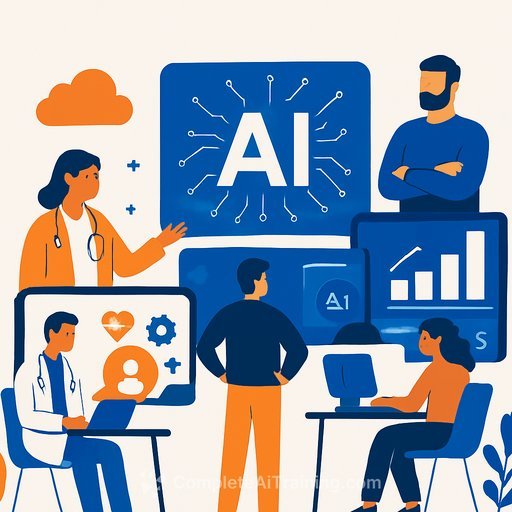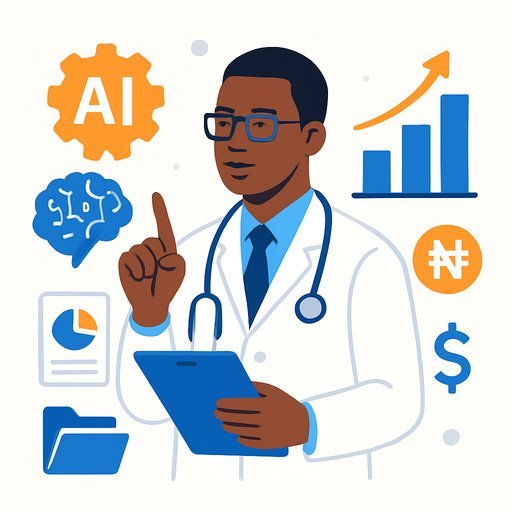AI's Impact Across Healthcare and Finance
AI has moved from hype to daily operations. It processes data at a scale humans can't touch, speeds up decisions, and boosts accuracy across high-stakes work.
The result: faster insights, fewer manual bottlenecks, and teams that can focus on higher-value problems instead of repetitive tasks.
What AI Does Well
- Pattern detection: Spots signals in imaging, claims, or transactions that are easy to miss.
- Automation: Handles repetitive work like scheduling, coding, triage, and alerting.
- Personalization: Adapts recommendations for patients and customers based on context.
- Decision support: Summarizes complex data and suggests next steps with clear rationale.
AI in Healthcare
Healthcare teams are using AI to improve care delivery without adding more strain to staff. The wins are practical, measurable, and already in production in many systems.
Diagnostics and Imaging
Computer vision models review X-rays, MRIs, and CT scans in minutes, flagging abnormalities and prioritizing urgent cases. This acts as a second set of eyes and helps reduce delays in treatment.
Regulators continue to review and clear new tools, which pushes quality standards higher and builds trust.
FDA: AI/ML-enabled medical devices
Drug Discovery and Development
AI sifts through chemical libraries, omics data, and literature to prioritize promising compounds and predict properties. Teams use it to reduce dead-ends earlier and focus lab time where it counts.
Administrative Efficiency
Appointment scheduling, intake, coding, denials management, and billing see meaningful gains from automation. Adaptive systems can cut wait times, reduce no-shows, and answer common questions fast.
The goal is simple: give clinicians more time with patients and less with paperwork.
AI in Finance
Financial institutions deploy AI where it reduces risk and lifts customer experience. Two areas stand out: fraud and risk.
Fraud Detection and Prevention
Models analyze transactions in real time, looking for anomalies across devices, geolocation, and behavior. Instead of blanket declines, systems trigger step-up checks and keep legitimate users moving.
Risk Management and Compliance
Credit risk models can evaluate more signals with better speed and stability checks. AI also helps with AML monitoring, KYC file reviews, and model documentation that satisfies audit requirements.
For governance and controls, a clear framework helps align teams across risk, compliance, and engineering.
NIST AI Risk Management Framework
Generative AI and Agents
Generative AI drafts clinical notes, patient summaries, compliance reports, and portfolio updates in minutes. It shortens the gap between raw data and clear communication.
AI agents can run multi-step workflows: pull EHR data, check guidelines, propose next actions; or in finance, assemble KYC files, monitor exposures, and alert on threshold breaches. Tight guardrails and review loops keep quality high.
Opportunities
- Healthcare: Earlier detection, more precise triage, faster documentation, and better patient throughput.
- Finance: Stronger fraud prevention, faster credit decisions, cleaner compliance evidence, and better client service 24/7.
Challenges to Address
- Data quality and access: EHR and core banking data are often messy or siloed.
- Privacy and security: PHI and PII need clear consent, encryption, and retention policies.
- Bias and fairness: Monitor inputs and outcomes; test across subgroups.
- Integration: Connect to EHRs, RIS/PACS, LOS, CRS, and payment rails without disruption.
- Model risk: Track drift, explainability, approvals, and versioning across the lifecycle.
- Change management: Train staff and define who reviews, overrides, and owns results.
Practical Next Steps for Healthcare and Finance Teams
- Pick one high-friction use case: Imaging triage, prior auth, denials, fraud alerts, KYC reviews, or customer service summaries.
- Run a data audit: Map sources, quality, lineage, and access rules. Remove sensitive data you don't need.
- Set policy early: PHI/PII handling, encryption, logging, human-in-the-loop, and escalation thresholds.
- Pilot in a sandbox: Start with a small cohort and pre-defined KPIs (turnaround time, accuracy, loss rates, CSAT).
- Measure and iterate: Compare against a control group. Keep what works; cut what doesn't.
- Plan MLOps: Version models, monitor drift, and set retrain triggers. Document for audit.
- Upskill the team: Short, role-based training speeds adoption and reduces errors.
Tools and Training
If you're building capability in-house, focused training and a vetted toolset shorten the learning curve.
- Role-based AI courses for healthcare and finance teams
- Curated AI tools for finance to explore fraud, risk, and automation use cases
Bottom Line
AI augments skilled professionals. Teams that pair strong data practices with thoughtful pilots will move faster, spend less, and deliver better outcomes for patients and customers.
Want structured guidance and vetted resources? Explore more at Complete AI Training.
Your membership also unlocks:










